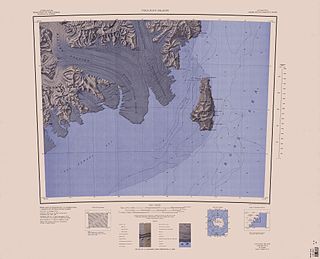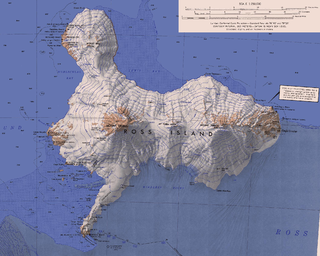
Borchgrevink Glacier is a large glacier in the Victory Mountains, Victoria Land, draining south between Malta Plateau and Daniell Peninsula, and thence projecting into Glacier Strait, Ross Sea, as a floating glacier tongue, the Borchgrevink Glacier Tongue, just south of Cape Jones. It was named by the New Zealand Geological Survey Antarctic Expedition, 1957–58, for Carsten Borchgrevink, leader of the British Antarctic Expedition, 1898–1900. Borchgrevink visited the area in February 1900 and first observed the seaward portion of the glacier.
Mount McIntosh is a mountain rising to about 2,600 metres (8,500 ft) in the western part of the Kyle Hills, on Ross Island, Antarctica. It stands at the northwestern end of Lofty Promenade, 1.5 nautical miles (3 km) east of the summit of Mount Terror. The mountain is conspicuous because of diagonal bands of rock and ice on the north face. It was named by the Advisory Committee on Antarctic Names in 2000, at the suggestion of Philip R. Kyle, after geologist William C. McIntosh of the New Mexico Institute of Mining and Technology. McIntosh worked extensively in Antarctica under United States Antarctic Program auspices and in support of Kyle's investigations on Mount Erebus, making his first trip to Mount Erebus in 1977–78, and at least 15 trips through 1999.
Catenary Nunatak is a nunatak 1 nautical mile (2 km) southwest of Monastery Nunatak on the south side of the Quartermain Mountains, Victoria Land. One of a group of names in the area associated with surveying applied in 1993 by the New Zealand Geographic Board; a catenary being the curve in which a survey chain hangs when it is suspended between two points at the same level.
Kyle Cone is an exposed volcanic cone near Cape Crozier, located 1.2 nautical miles (2.2 km) west-northwest of the summit of The Knoll in eastern Ross Island, Antarctica. It was named by the New Zealand Antarctic Place-Names Committee after Philip R. Kyle, a geologist with the Victoria University of Wellington Antarctic Expedition, which examined the cone in the 1969–70 season.
The Knoll is a snow-free knoll, 370 metres (1,200 ft) high, surmounting Cape Crozier at the eastern extremity of Ross Island, Antarctica. It was discovered and named by the British National Antarctic Expedition, 1901–04, under Robert Falcon Scott.
Guardrail Ridge is a ridge 2 nautical miles (4 km) long located 2 nautical miles west-southwest of The Tooth in the Kyle Hills of Ross Island, Antarctica. The ridge rises to 2,200 metres (7,200 ft) at Sherve Peak. The name, given by the Advisory Committee on Antarctic Names in 2000, alludes to the position of the ridge along the southern margin of Lofty Promenade.
Tramway Ridge is a ridge that rises to about 3450 m above sea level in the north-west part of the summit caldera of Mount Erebus on Ross Island, Antarctica. The ridge is formed by the levees (banks) on the side of a young lava flow. The appearance of the feature is suggestive of a set of railway or tram lines.
Parawera Cone is a cone rising to c.1300 m at the northeast end of Tekapo Ridge in Kyle Hills, Ross Island. The cone is 1 nautical mile (1.9 km) northwest of Ainley Peak. The name Parawera is one of several Maorai wind names applied by New Zealand Geographic Board (NZGB) in this area.
Driscoll Point is a point forming the east side of the entrance to Wise Bay, overlooking the Ross Ice Shelf. It was mapped by the United States Geological Survey from tellurometer surveys (1961–62) and Navy air photos (1960), and was named by the Advisory Committee on Antarctic Names after C.E. Driscoll, Master of the USNS Private Joseph F. Merrell during U.S. Navy Operation Deep Freeze 1963.
Eastwind Glacier is a glacier that drains part of the southern slopes of Mount Terror in southeast Ross Island. It flows southwest and coalesces with the eastern margin of Terror Glacier where the two glaciers enter Fog Bay. In association with the names of expedition ships grouped on this island, it was named after USCGC Eastwind, an icebreaker that made nine Antarctic deployments in support of science activities from U.S. Navy Operation Deepfreeze, 1955–56, through the 1966–67 season.
Moore Peak is a peak rising to about 2,500 metres (8,200 ft) on the west slope of Mount Terror, Ross Island, Antarctica. The peak is 1.6 nautical miles (3 km) west-southwest of the summit of Mount Terror and 1 nautical mile (2 km) south of Mount Sutherland. At the suggestion of P.R. Kyle it was named by the Advisory Committee on Antarctic Names in 2000 after James A. Moore, a member of the New Mexico Institute of Mining and Technology team on Mount Erebus in the 1983–84 and 1985–86 field seasons. He completed his Master of Science thesis on the geology of Mount Erebus.
Lofty Promenade is an inclined glacial course, 7 nautical miles (13 km) long and 1 nautical mile (2 km) wide, in the eastern part of Ross Island, Antarctica. The feature is partly framed between the southern elements of the Kyle Hills and Guardrail Ridge, as it descends east-southeast from 2,600 metres (8,500 ft) near Mount Terror to 200 metres (660 ft) near the Allen Rocks. The glacial surface is relatively smooth and affords an unobstructed route between the Cape Crozier area and Mount Terror. The name, given by the Advisory Committee on Antarctic Names in 2000, is allusive and refers to a public place for taking a leisurely walk.
Mount Melton is a squarish mountain 1.3 nautical miles (2.4 km) west of Tent Peak in the Kyle Hills of Ross Island, Antarctica. The feature rises to about 2,000 metres (6,600 ft) on the north side of Lofty Promenade. The mountain was named by the Advisory Committee on Antarctic Names in 2000 after Terry Melton, a power plant mechanic/facilities engineer at Palmer Station, June 1981 to January 1983. Melton worked nine WINFLY/summer seasons at McMurdo Sound as Williams Field facilities engineer/site supervisor, McMurdo operations superintendent, and McMurdo area manager, 1984–93, and then as National Science Foundation McMurdo Station manager from October 1998 to October 1999.
Cape MacKay is an ice-covered cape which forms the southeastern extremity of Ross Island, Antarctica. It was discovered by the British National Antarctic Expedition (1901–04) and named for Captain Harry MacKay, commander of the Terra Nova, one of the relief ships for the expedition.
Scanniello Peak is a peak which rises to 2200m and marks the highest and SW-most point of Tekapo Ridge in Kyle Hills, Ross Island. Named by Advisory Committee on Antarctic Names (US-ACAN) (2000) after Jeffrey Scanniello, long-term ASA field engineer, who was active in surveying at McMurdo and South Pole Stations from 1990; member of McMurdo Station winter party, 1994.
Slattery Peak is a somewhat isolated rock peak that rises above the ice mantle southeast of Mount Terror on Ross Island. The peak position is additionally defined as 5.5 nautical miles (10 km) southwest of The Knoll and 3.8 nautical miles (7 km) east-northeast of Rohnke Crests. Named after Leo Slattery, who wintered at Scott Base three times, twice as Officer in Charge; Post Clerk on Ross Island, summer 1973-74; Postmaster on Ross Island, summers 1979-80, 1981–82, and 1983–84.
Mount Terra Nova is a snow-covered mountain, 2,130 m (6,990 ft), between Mount Erebus and Mount Terror on Ross Island. First mapped by the Discovery expedition 1901-04, and named for Terra Nova, relief ship for this expedition and the British Antarctic Expedition, 1910-13.
Tent Peak is a tent-shaped peak rising to about 1,570 metres (5,150 ft) midway between Mount Terror and Cape Crozier in eastern Ross Island. Descriptively named by a party of the New Zealand Geological Survey Antarctic Expedition (NZGSAE), 1958–59, which occupied the peak as an astronomical control station, January 5, 1959, and erected a tent below the peak.
South East Point is a point 1.9 km (1.2 mi) east-north-east of Fildes Point, marking the south-eastern point of Deception Island, in the South Shetland Islands of Antarctica. It was charted by a British expedition 1828-31, under Henry Foster. The name was proposed in 1949 by the Hydrographic Department of the Admiralty, following a survey of the island by Lieutenant Commander D.N. Penfold, Royal Navy, in 1948-49.



![]()


